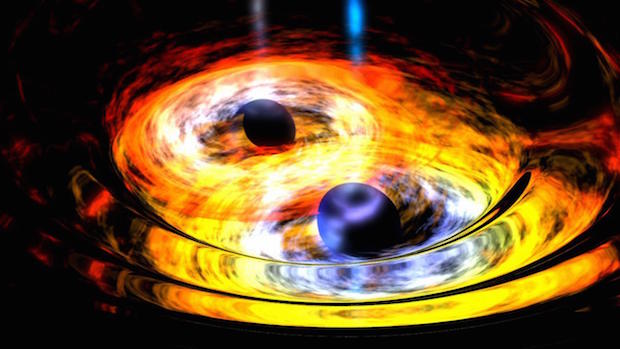
credit: NASA
Last week astronomers announced the first ever detection of gravitational waves. This detection not only confirms Einstein’s theory of general relativity, but also has implications that affect both the observational and theoretical astrophysics. In this article a few examples of these implications are mentioned.
Observational astronomy uses the electromagnetic spectrum to study the universe, thus leaving objects that do not radiate in the electromagnetic spectrum, unnoticed. The ability to detect gravitational waves provides us a new window to the universe.
The source that generated the gravitational waves is a binary system of massive stellar black holes. This is the first definitive identification of binary systems consisting of two black holes. It is also impressive that the two black holes are the largest of their kind to have been observed, with masses that exceed 30 solar masses. The question of how so massive stellar black holes form is a puzzle for astrophysicists. Scientists found that their most likely progenitor consists of a primary star in the mass range 40-100 solar masses and a secondary in the mass range 40-80 solar masses that interacted and formed the black holes without exploding as supernovae. The two black holes merged, leading to a rotating black hole remnant with mass 62 times the mass of the Sun and spin of 0.67. Comparing these estimated values for the mass and spin of the black hole with those inferred from the oscillations in the detected wave, astronomers were able to test and confirm the predictions of general relativity. In addition, by analyzing the phase of the gravitational waves they determined an upper bound on the mass of the graviton, the hypothetical quantum particle that mediates gravity.
Short Gamma-Ray Bursts, are extremely energetic explosions of gamma rays that last for less than 2 seconds. Current paradigms indicate mergers of Neutron Star-Neutron Star or Neutron Star-black hole binaries as the triggering mechanisms of this phenomenon. Recently, the Fermi satellite detected a short Gamma Ray Burst in association with the gravitational wave signal that has shaken this standard paradigm. Researchers showed that two high-mass, low-metallicity stars undergoing a weak supernova could produce a short gamma-ray burst, without the presence of one neutron star to be required.
Apart from the earth based detectors for gravitational waves (LIGO, VIRGO, KAGRA), space-based detectors, like eLISA will allow us to look deeper in the universe and understand the formation processes of massive black holes binaries.
Publications: Belczynski et al. 2016, Perna et al. 2016, Seto 2016
